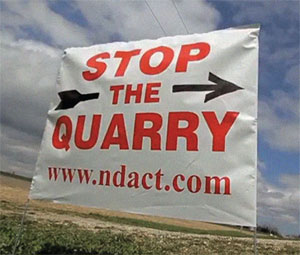Ontario risks losing a huge swath of prime farmland to the Melancthon quarry
Matthew Strader

Sign for the North Dufferin Agricultural and Community Task Force protesting the Melancthon Quarry. Photo courtesy NDACT.
Carl Cosack wonders who is standing on guard for his piece of Ontario. The 52-year-old rancher manages a herd of black angus cows and 30 horses, making him one of Ontario’s last traditional trail hands and proud owner of one of the province’s few remaining amateur ranches (don’t call it a “dude ranch”). Thanks to a bid to build one of the world’s largest limestone quarries in his backyard, Cosack can also add “activist” and “lobbyist” to the mix.
Cosack is vice-chair of the North Dufferin Agricultural and Community Task Force, whose main goal—along with trying to effect larger policy change—is to oppose the Highland Companies’ application for a 2,316 acre quarry in Melancthon Township, about 60 km north of Brampton. Many in the area never saw it coming. Highland, a group of investors backed by the US$23-billion Boston-based hedge fund Baupost, bought the first farms in Melancthon Township in 2006, under the name Headwater Farms. Starting out as potato farmers, the company soon accumulated 8,500 acres—then came the quarry application. “People in the area just started asking questions,” Cosack says. Mostly: Who’s going to stop it?
Highland’s land includes parcels of farmland classified as Honeywood Silt Loam—some of the finest agricultural soil in Canada. That’s a key point for Leo Blydorp, director and policy advisor of the Dufferin Federation of Agriculture. The idea that Canada is a vast and underdeveloped land mass is wrong, he adds. In fact, 89 percent of Canada’s land mass is unsuitable for agricultural use, he says, and only 0.5 percent of Canada’s agricultural land is in the top class. More than half of that is in Ontario. “We continue to lose prime agriculture land at an alarming rate in Canada,” says Blydorp, “and in Ontario specifically.”
Then there’s the water. The proposed quarry is at the headwater of several major rivers that run in different directions into the remainder of the urbanized south. “They’re talking about managing 600 million litres of water a day,” says Cosack—the daily usage equivalent to 2.7 million Ontarians. Likely, it’s these concerns, and others, that prompted the Ontario government to call for a full environmental assessment of the project in September (although some feel it had more to do with election timing).
Kate Jordan, spokesperson for the Ministry of Environment, says the EA process will give concerned residents like Cosack a more formal opportunity to get educated, and involved. “There will be much more complex studies and more information,” she adds. The process also encourages every concerned Ontarian to speak up. Which would be nice, says Cosack. After all, he’s got a ranch to run.